Ever since the invention of the telephone in 1876, its design had been evolving era after Era. Now in the present, these unique telephone designs of Old are very attractive, rare, and thus valuable enough to be considered pricey collectibles for your antique collection.
According to the historical trend of telephones, they all followed a similar working principle since their invention. But their style did change over time. From candlesticks (which had their microphone, receiver, and ringer detached from each other via wires) to advanced mobile phones (which had all components on a single apparatus). In the antique market today, the most valuable pieces are earlier models that possessed uncommon designs. That also offered a retro style to any modern room setting.
And apart from the structure of these telephones, there are various other ways to determine their value which will be discussed later on. Along the way, we’ll also provide the top 10 Most valuable Antique telephones in the world to get great comparable estimates.
Table of Contents
The History of Antique Telephones
- The first-ever telephone that was commercially sold was a large wall-mount that had all its components enlarged. This style of phone is powered by a crank. Users of this design of phones usually refer to them as coffin phones or camera phones due to their big and boxy look.
- After the big crank wall phones, the next big thing was the candlestick design which was invented in the early 1900s. It consists of a tall, thin centerpiece with a round standing base and an earpiece hanging on the sides of the slender centerpiece. With this device, you can communicate your message through the thin and long centerpiece via an entry that serves as the microphone.
- The device also comes with a boxed ringer which helps to indicate if you’re receiving a call. Operator phones were used along with the candlestick from 1892 to 1910 to make outgoing calls. Rotary dials were then used to make outgoing calls with the candlestick phone from 1910 until 1920.
- During and after 1920, telephones had a much simpler design with all two major components (microphone and the receiver) on one apparatus. However, the wooden or brass box usually carried the ringer and they were mounted on walls. While the telephone was placed either on the side of the box or telephone table.
- By 1930 and later, the design of the telephone became a lot more compact to save enough desk space for other items. The microphone, receiver, and ringer are all in one apparatus. With a rotary dial box connected via a wire.
- But upon the beginning of the second world War, telephones were made strong. As such devices during this period were made almost completely out of metal (including the insides) except for the exterior which is usually made out of bakelite. The reason for this design was to strengthen communication devices to help make them durable during a battle.
- After world war 2, phones were predominantly made of plastic and smaller. Thus making them lighter and allowing them to occupy much less space than the designs that preceded them.
- The 1960s to 70s consisted majorly of telephones with a number buttoned box instead of a rotary dial.
- Later on, leading to the 2000s, phones were manufactured to be a lot smaller and maybe more durable. Depending on the specific rolled out by companies in charge of their products and their customers’ wants.
Identifying Different Styles Of Antique Telephones
Loads of designs and concepts for the telephone were fabricated since its inventions. This makes identifying them harder. However, you can take advantage of the antique telephone designs that were popular during each Era.
Here are five popular styles of antique telephones:
Wooden Wall Telephones
Since the invention of the telephone, the first design that was commercially distributed is the wooden wall telephone. This piece consists of a large wooden Rectangular box that contains all the essential components within the box. Except for the receiver that points directly at the user to serve as a microphone and ringers to indicate an incoming call.
Such a device adopted the crank system for making outgoing calls. How does it work? The user pushes the operator button on the side and gives the crank a long wind. After winding, the user should place the earpiece on his/her ears and wait for a switchboard operator to respond. Once they do respond, you should dictate the number of the person you wish to call and his/her name for accuracy.
There were several designs of the wall box telephone. Such as:
- The two box wall phone
- Fiddle-back wall phone
- Plain front & Picture frame front wall phone
Two box wall phone
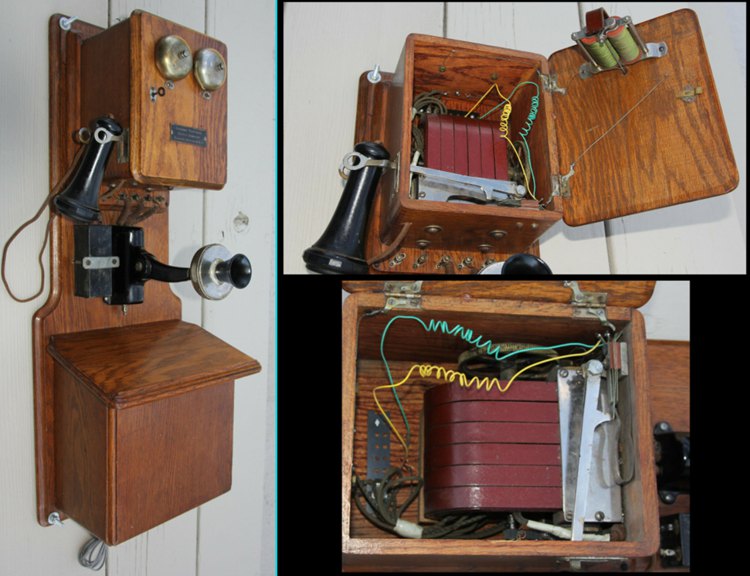
The first-ever was the two-box wall phone. Where the major large box contained components such as the external receiver, ringers, and earpiece. The other box however contained larger magneto batteries. These batteries power the wall box telephone as long as you wind the crank system. Such a design was popular until 1895.
Fiddle-back wall phone
This is also a popular design variation of the wooden wall box which was first fabricated in 1895 until the early 1900s. It consists of a large box with a fiddle-style shaped back (a shape that’s similar to the structure of a violin). However, its physical feature happens to be the only difference between the two-box design. As both the fiddle back and two box designs share the same components. Such as the batteries in a secondary box, and an external receiver sticking out.
Note: these types of wall phones were only made between 1895 and 1900. Also, not all their units are battery-powered. Some were also directly connected to a nearby telephone company. These facts make them rare and in turn more valuable in the antique market.
Plain Front & Picture Frame Front Wall Phone
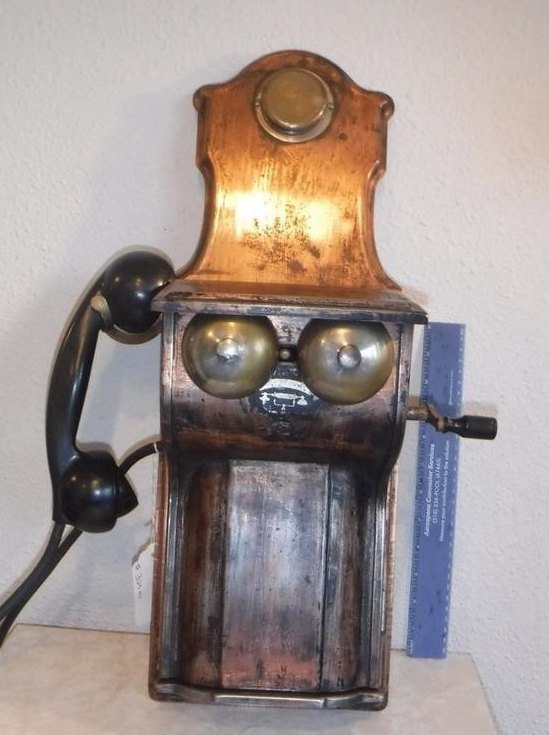
Both front wall phones are of similar designs. You can see evidence such, as they both use magneto batteries. The only difference is that one has decorative routings on its front surface while the other is plain.
Note: These front wall phones were made by prominent companies such as western electrics from the 1900s all through to the 1930s.
Candlesticks
While the reign of the wall box telephone was fading away, a new design was already penetrating the market around the late 19th century, going into the 20th century. Which was the candlestick telephone.
What Does it look like? Its name is pretty much self-descriptive with its long tall cylindrical mouthpiece standing upright like a candlestick. While being supported by a stand and supporting an earpiece on its side. Next to the telephone set described is a ringer box which is usually mounted on the wall or desk.
After the 1910s, the candlestick telephone adopted the rotary dialing system. Which eliminates the need to call a switchboard operator. Given that you can contact another user directly.
Desk Set
These are telephone sets that are designed specifically to occupy desk space. And their design consists of all components such as the telephones, rotary dial, and ring are all in the same apparatus.
Western Electric
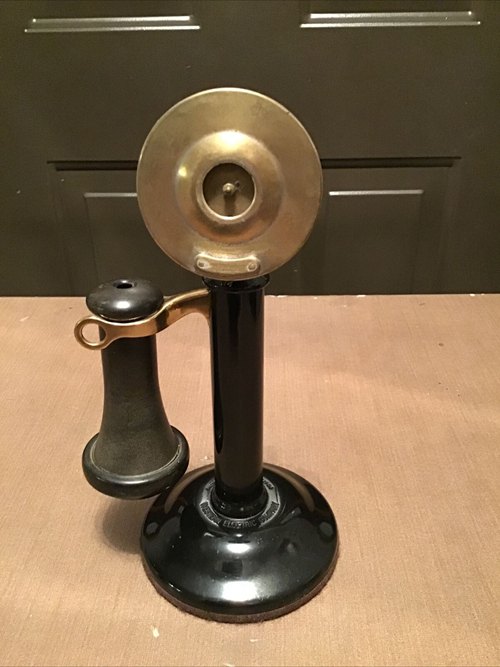
Antique telephones made by western electrics are usually boxy in design. And users of their product were well-accustomed to the bell ringing sound or tunes.
Bell’s Systems
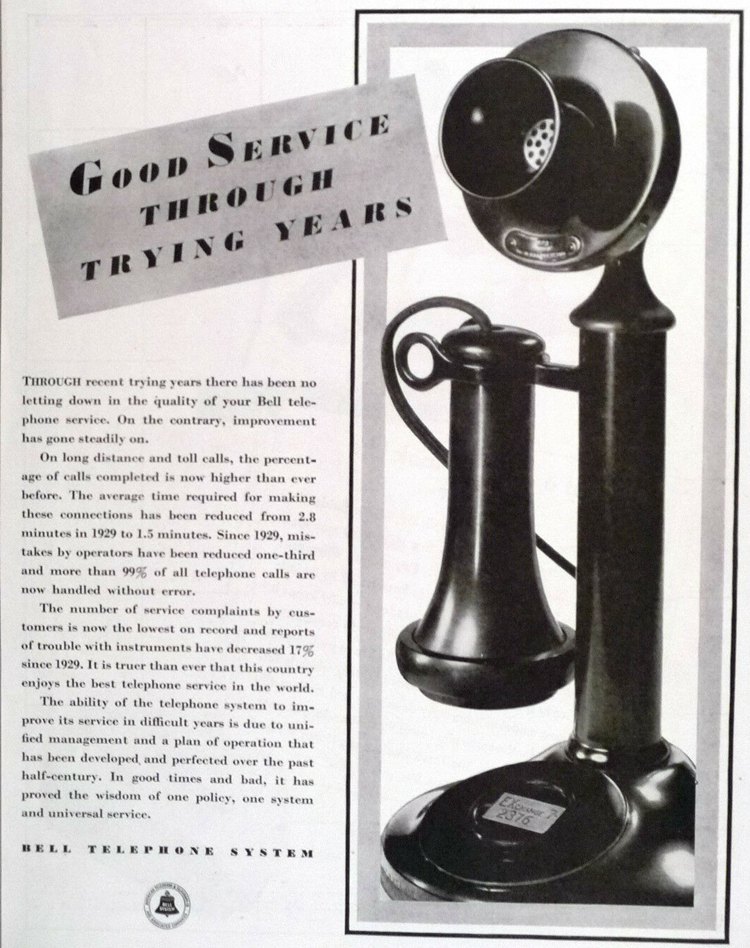
These are antique telephones designed by Alexander Graham Bell’s company. They produced beautiful antique telephones of various shapes and a ton of colors. So they weren’t as uniform in their design as other companies like western electrics were.
Payphones
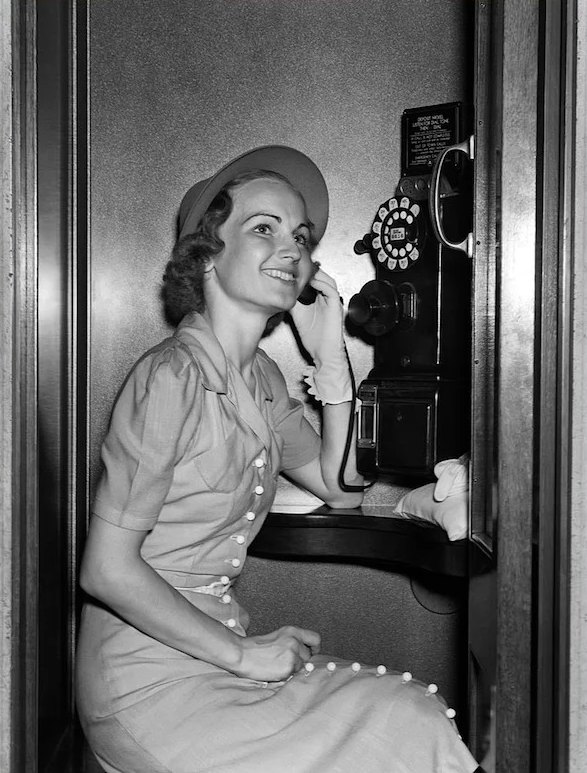
These are Coin-operated phones which are also known as payphones. It was invented and patented by Gray Hartford in 1889.
Companies To look out for
Here’s a list of all the popular companies that made antique telephones:
- Kellogg Switchboard and Supply Co.
- North Electric Co.
- early candlestick manufacturers
- Western Electric Co.
- Gray Telephone and Pay Station Co.
- Automatic Electric Co.
- Stromberg Carlson Co.
Note: the inscriptions on their product consist of the company’s primary name as there’s no special code.
Antique Telephones Value: How To Determine Them
Do Your Research
One of the best DIY approaches is to perform rigorous research on your antique telephone piece. This means you have to find out certain features such as the age of the piece, its maker, and design type. Such information will allow you to identify when your antique telephone was made and its style during that time.
You can also approach research by image fishing on Google or binge. As this will most likely give you access to online antique Appraiser sites that should offer you an idea of your Telephone’s value. Or you can visit antique telephone forums which can give you access to other antique telephone enthusiasts or collectors. That can offer advice on how to value your piece.
Another way to perform research on the value of your piece is to compare prices with previously made auction sales. This may not be entirely foolproof but it can get you in the ballpark when it comes to pricing.
Access the Ideal condition
Demand from antique collectors will always vary. And it should be your aim to choose which demand to supply that will provide you with maximum gain. For instance, a fellow interested collector or buyer might be looking for a working antique telephone while others may prefer that your antique telephone remains in its original state.
Hire an Appraiser
Hiring an expert in the field could speed up the process of valuing your antique telephone. Because the appraiser would already have a specific template from which he or she can make a proper judgment on the value.
Age Of The Telephone
Another great way to determine the value of your antique telephone is by knowing its age. And you can note this from the design of the piece. For instance, the earliest models of antique telephones were big, boxy, and relied on a crank to power them (1895 – 1900). Then over time, antique telephone designs got a lot simpler and more compact (candlesticks with rotary dials, desk phones).
9 Things That Make Antique Telephones Valuable
Provenance
This is any sign or evidence that your antique telephone was owned by a famous person. Or previously housed in a very important building. Such a factor tends to shoot the price of your Antique telephone piece high.
Rarity
Your antique telephone becomes valuable if its model or design happens to be in short supply. A good example is the prototype phones that were never really popular during their Era. If it could be because it failed to woo customers or there wasn’t enough capital to boost the idea or the device just happens to be too inconvenient when compared to popular alternatives.
However, such models are considered “hot cake” in today’s market. As atypical designs do attract more value than common, mass-produced units. You can also make the same case for fiddle-back wall phones which had a very short run (from 1895 to 1900).
Condition
The condition of your antique telephone plays a major role in valuing it. So, if your antique telephone is missing a replaceable piece then the price may drop a bit. All it would take in that scenario is to replace the missing detachable part so that you can sell at full price. But if your antique telephone is damaged beyond repair, all you’ll be left to do is to mask it. Although this won’t do much for your telephone’s plummeting price.
Authenticity
Fake antique phones have no value. Reproductions either in parts or an entire phone have much less value. However, it’s very hard to detect reproductions. So price sparring between the collectors can be very difficult and one could be bullied into accepting the buyer or seller’s financially inconvenient price. But if you’re able to prove its Authenticity then the pricing power falls on you.
Completeness
Given that phone companies popularly leased out their telephones during the early years of their invention, there’s a high chance not all of its pieces are original. Why? It’s due to the constant practice of repairing and improving them while disposing of old parts. Which are the accessories that originally came with the antique telephone.
Aesthetic
The more attractive the piece is the more pricey it becomes. For instance, an Antique Telephone that’s rich in colors is more valuable. The same goes for nickel-made candlestick telephones which should be shiny.
Can it function?
It’s all down to the Collector’s demands. Whether he or she would prefer the antique item fixed to ensure a good working condition. Or he or she might demand that you don’t work on the antique piece. As it would risk the pureness of the piece and thus negatively affect its value.
Scarcity
This factor hinges on the feature of the antique telephone. For instance, there are old western electric telephones which don’t have letters or numbers on the finger-stops of their rotary dial system. But some do, and they are quite uncommon.
The same can be said about fiddle back Wall telephones which are powered directly by nearby telephone companies. Such units are somewhat rare due to their short run (1895 – the 1900s). And the fact that both batteries (magneto) powered fiddle back telephones units and units that get their power directly from an eternal source (nearby company) were made during that short period.
Does Age Really Matter?
Age alone isn’t enough to determine the value of your antique telephone. It’s best done with another factor that encourages the Collector’s demand. And that is scarcity. For instance, if your antique telephone is just one of many that have been mass-produced during its time, its value would drop.
However, if your antique telephone happens to be made later and its kind is rare, then its value Is bound to be high.
Top 7 Valuable Antique Telephones In The World
7. Antique Vintage Phone Oak Wall Old Crank Telephone Authentic 1900s
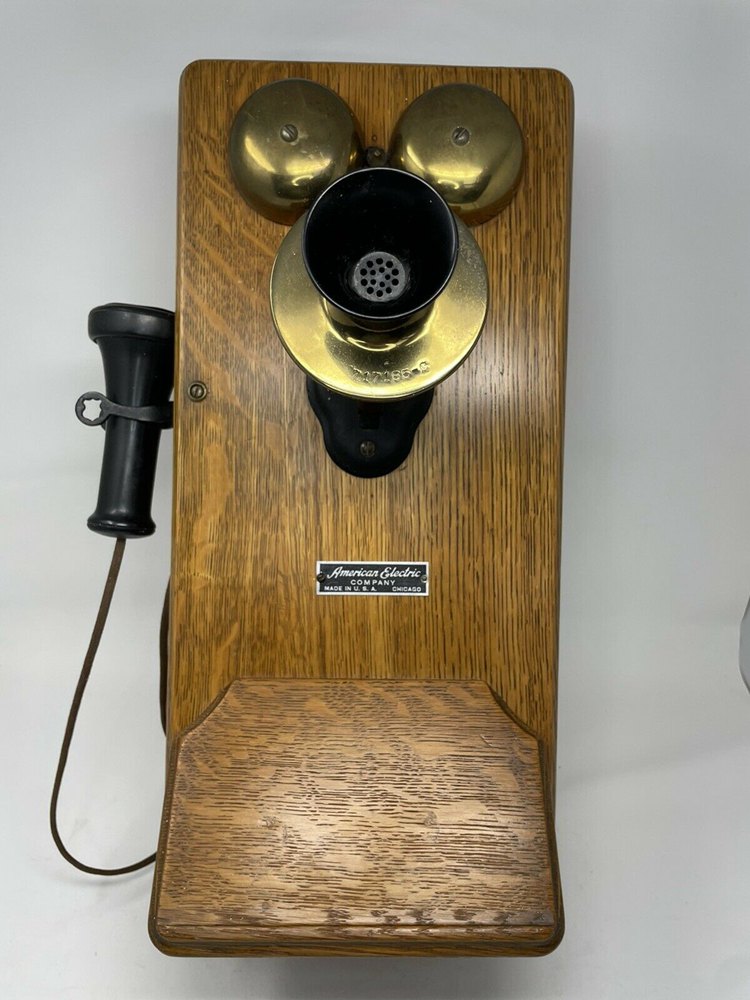
This is an oak-wooden box wall phone with a magneto battery compartment, an earpiece, and a crank on the side. It’s one of the late 1800s to early 1900s units that were manufactured by Kellogg Switchboard and Supply Co. As you’d notice an engraved inscription on its metal-made speaker.
Price range $(100 to 250)
6. Antique Wood Portable Crank Field Telephone Early 1900s Very Good Original Cond.
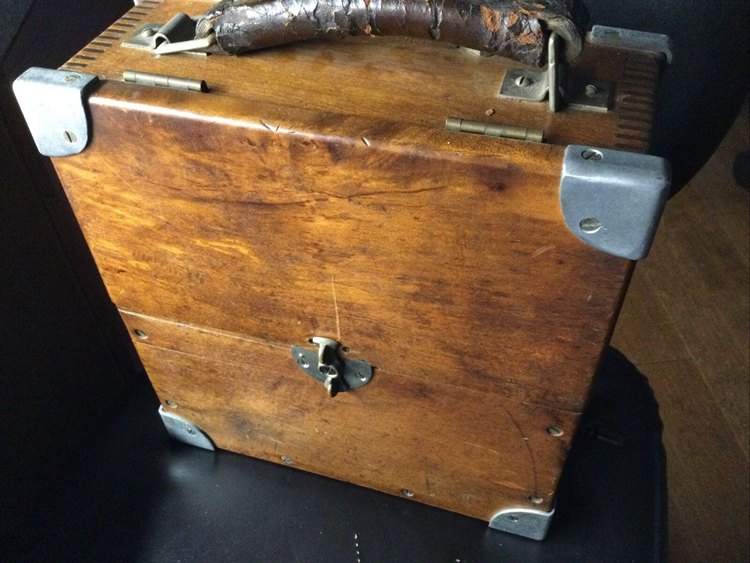
western Electric offers some of the most intriguing designs and their portable crackable telephone is evidence of that. This special piece was probably manufactured during the early 1900s. Its structure consists of a suitcase which contained all components such as the magneto batteries, the telephone (earpiece and mouthpiece in one apparatus), and the ringer.
Price range$(400 – 600)
5. Western Electric 1915 Antique Desk Phone Black Telephone Candlestick Keystone
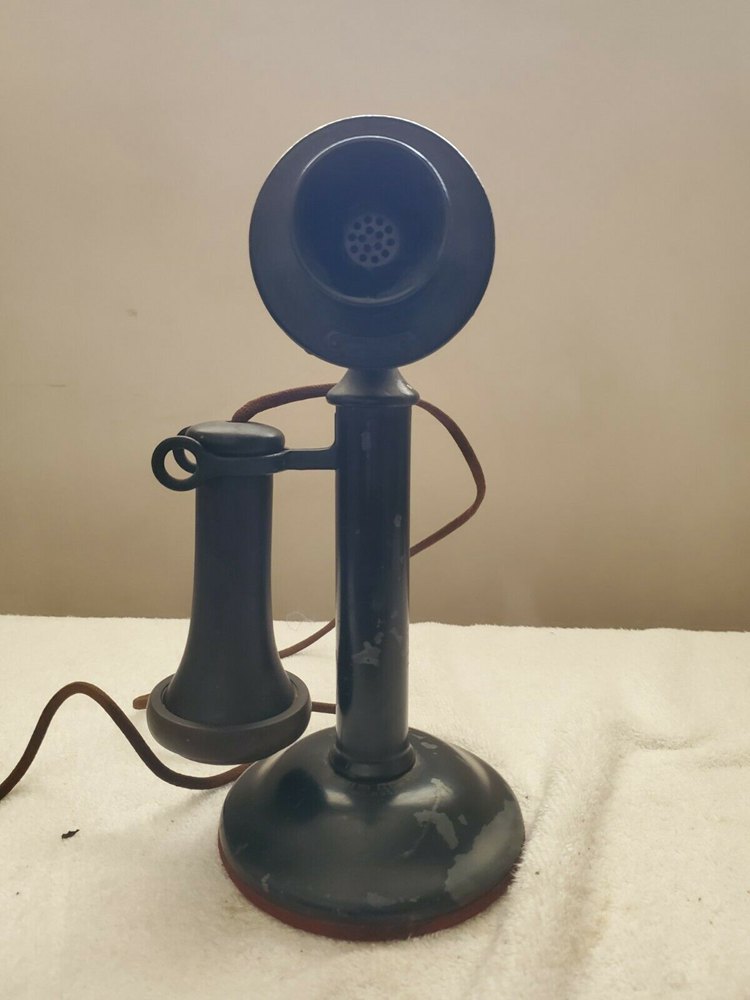
This right here is a desk candlestick telephone. Although it was first manufactured during the early 1900s, this piece, in particular, has proof that it was manufactured in 1915. As there’s an inscription along the base that says so. It also says it was made by western electric.
Price range $(250 – 500)
4. Antique Payphone 3 Coin Slot LPB-89-55 Red Phone by Automatic Electric *Rough*
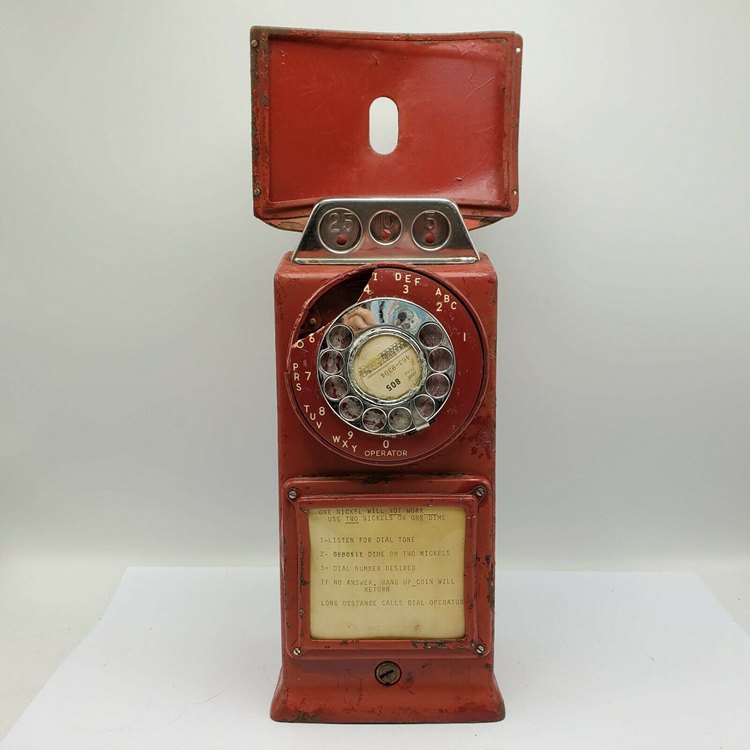
Automatic Electric Co. Is one of the few popular companies that manufactured payphones. You can tell from the design it’s a retro piece (the 1940s – 1960s), due to its metal build and three coin slots for different coin sizes.
Please Note: This happens to be damaged but it still has value.
Price range $(200 – 220)
3. Vintage Solid Brass Candlestick Rotary Telephone Phone GEC England Works
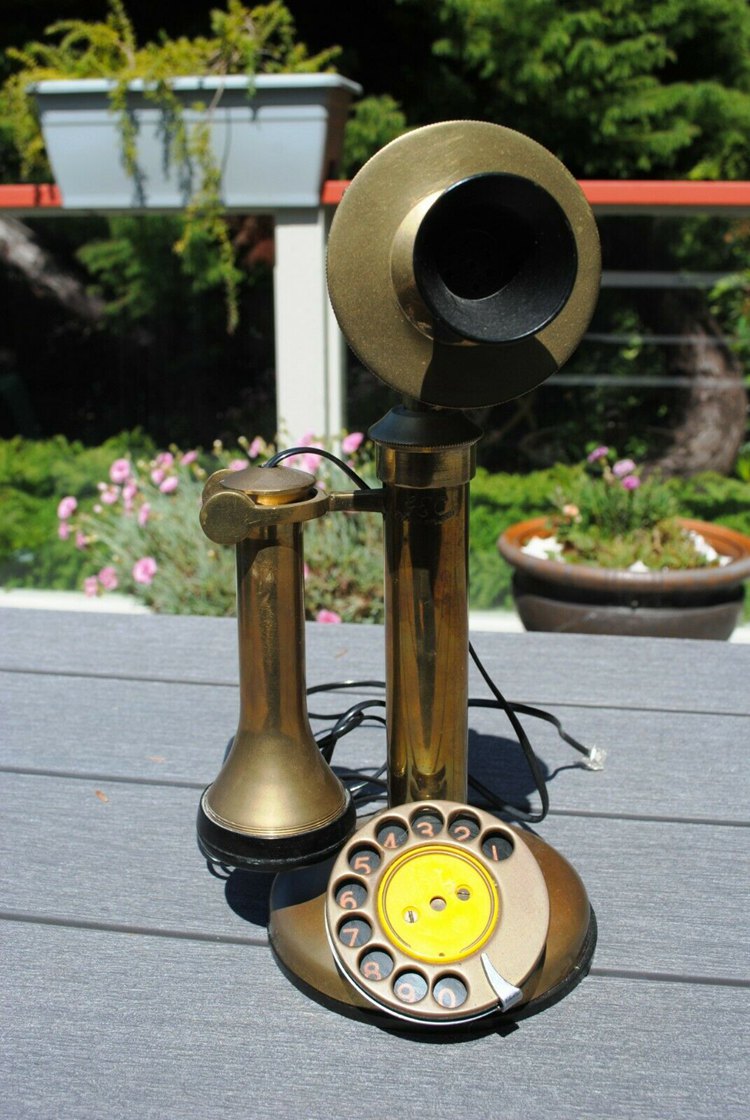
This is a candlestick phone that can make outgoing calls without a switchboard operator. Due to its rotary dialing features. It has no modified parts or damaged ones.
Price range $(200 – 250)
2. Antique 1915 Western Electric Candlestick Telephone Walnut Ringer Box Working
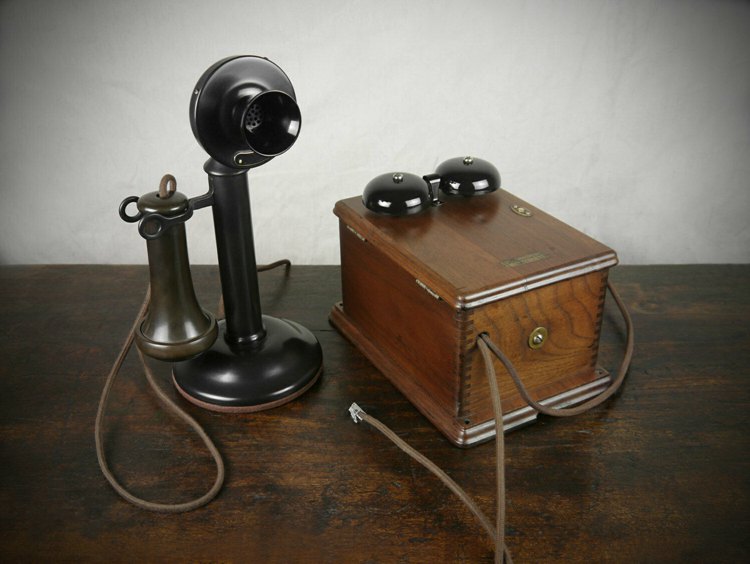
Here’s another antique candlestick telephone that would go great with your retro desk setup. Its structure consists of a shiny black candlestick metal frame connected to the earpiece and ringer box Via original wires. Its ringer box however is of a fine brown oak color.
Price range $(1000 – 1500)
1. Automatic Electric Monophone 1930’s Deco ~ Antique Telephone ~ RARE Ringer Base
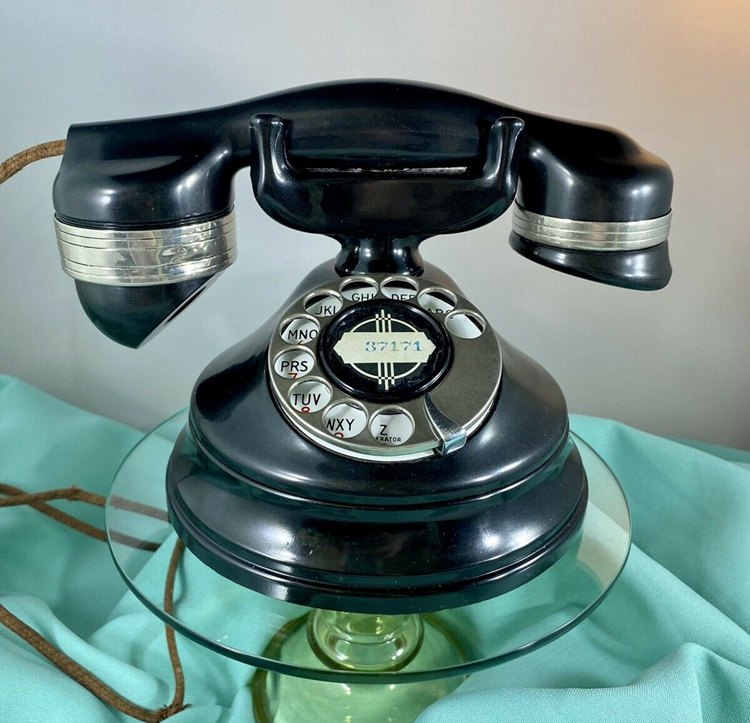
This is an art-Deco mono phone desk original piece from the 1930s which has a rotary dial and ringer base. Completely convenient for desk spaces and will design adds a lot of style to your office or sitting room set up.
Price range $(1000 – 2000)
Where to Buy an Antique Telephone
You can purchase antique telephones from foolproof online sites such as ruby lane, 1stdibs, Etsy, and eBay. However, there’s still a greater level of risk behind purchasing antique products online. Because you don’t get to physically examine if the antique is in mint condition or not. This is why it’s a lot better to go to your local antique store.
Additional Online Resources
You can get all the information you need from the antique Appraisal site. They’re capable of starring you in the right direction when it comes to valuing your piece. Especially if the appraisal site centers on antique telephones. Additional information can also be gotten from forums such as classic rotary phones forum, telephone collectors forum, and Antique Telephone Collectors Association.
Final Words
You should be able to tackle the uncertain and chaotic antique telephone market by now. As we’ve provided a comprehensive guide that touches on all the necessary information such as the significant historical timelines of various telephone styles, and how to identify them and value them. So that you need to plow through all caveats involved in collecting, buying, and selling antique telephones.






![Vintage Schwinn Bikes: [Types, Identification, and Values]](https://www.txantiquemall.com/wp-content/uploads/2022/05/5.-Schwinn-1967-Ramshorn-Fastback-Stingray-Sky-Blue-vtg-600x450.jpg)
